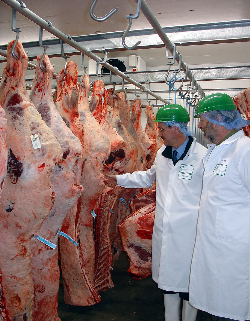
Farmers should work more closely with the meat supply chain to ensure more of their cattle and sheep meet market requirements, according to an ADAS demonstration in Essex hosted by Direct Meats, specialist suppliers to the catering trade.
Figures from the English Beef and Lamb Executive (EBLEX) show that less than half of all stock sold is within the market target for prime English beef, with producers of all types of beef having scope to increase returns by improving cattle conformation and also fat levels to better match what is required.
After inspecting cattle to be sold at Colchester Livestock Market, the farmers went to the Direct Meats' cutting plant at Chappel where they were joined by chefs to see beef and lamb being prepared for some of the region's leading restaurateurs and caterers.
The event was organised by ADAS and Defra to encourage farmers to work more closely with the red meat supply chain — auctioneers, abattoirs, meat processors, butchers and caterers.
"It can only be a positive step forward to bring together farmers, butchers and chefs to share ideas on how best to produce the highest quality British meat," said Martyn Cox, director of Direct Meats.
"Our customers, among them a number of top chefs, are very demanding in what they expect of our products — in terms of portion control, eating quality, amount of fat coverage and marbling — and so we have to set high standards for the meat we buy.
"We are looking all the time to source more meat locally to add to the British Excellence premium brand we launched last year and we shall certainly be developing contacts we've made during the event."
After tasting some of their hosts' products, the visitors heard how genetics, management and nutrition greatly influence the quality of beef and lamb — and impact on financial returns.
